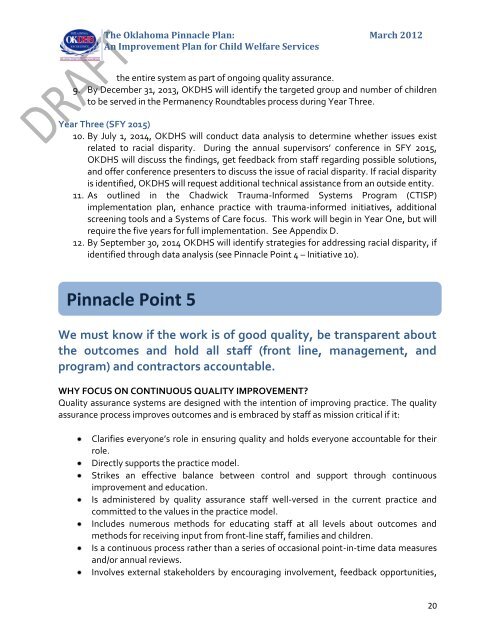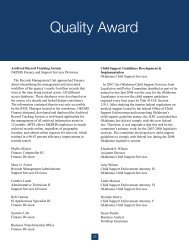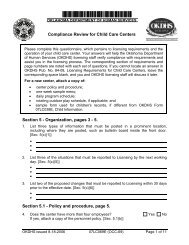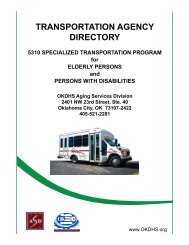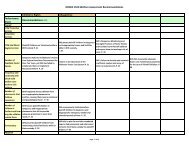The Oklahoma Pinnacle Plan - Oklahoma Department of Human ...
The Oklahoma Pinnacle Plan - Oklahoma Department of Human ...
The Oklahoma Pinnacle Plan - Oklahoma Department of Human ...
Create successful ePaper yourself
Turn your PDF publications into a flip-book with our unique Google optimized e-Paper software.
<strong>The</strong> <strong>Oklahoma</strong> <strong>Pinnacle</strong> <strong>Plan</strong>:<br />
An Improvement <strong>Plan</strong> for Child Welfare Services<br />
March 2012<br />
the entire system as part <strong>of</strong> ongoing quality assurance.<br />
9. By December 31, 2013, OKDHS will identify the targeted group and number <strong>of</strong> children<br />
to be served in the Permanency Roundtables process during Year Three.<br />
Year Three (SFY 2015)<br />
10. By July 1, 2014, OKDHS will conduct data analysis to determine whether issues exist<br />
related to racial disparity. During the annual supervisors’ conference in SFY 2015,<br />
OKDHS will discuss the findings, get feedback from staff regarding possible solutions,<br />
and <strong>of</strong>fer conference presenters to discuss the issue <strong>of</strong> racial disparity. If racial disparity<br />
is identified, OKDHS will request additional technical assistance from an outside entity.<br />
11. As outlined in the Chadwick Trauma-Informed Systems Program (CTISP)<br />
implementation plan, enhance practice with trauma-informed initiatives, additional<br />
screening tools and a Systems <strong>of</strong> Care focus. This work will begin in Year One, but will<br />
require the five years for full implementation. See Appendix D.<br />
12. By September 30, 2014 OKDHS will identify strategies for addressing racial disparity, if<br />
identified through data analysis (see <strong>Pinnacle</strong> Point 4 – Initiative 10).<br />
<strong>Pinnacle</strong> Point 5<br />
We must know if the work is <strong>of</strong> good quality, be transparent about<br />
the outcomes and hold all staff (front line, management, and<br />
program) and contractors accountable.<br />
WHY FOCUS ON CONTINUOUS QUALITY IMPROVEMENT?<br />
Quality assurance systems are designed with the intention <strong>of</strong> improving practice. <strong>The</strong> quality<br />
assurance process improves outcomes and is embraced by staff as mission critical if it:<br />
Clarifies everyone’s role in ensuring quality and holds everyone accountable for their<br />
role.<br />
Directly supports the practice model.<br />
Strikes an effective balance between control and support through continuous<br />
improvement and education.<br />
Is administered by quality assurance staff well-versed in the current practice and<br />
committed to the values in the practice model.<br />
Includes numerous methods for educating staff at all levels about outcomes and<br />
methods for receiving input from front-line staff, families and children.<br />
Is a continuous process rather than a series <strong>of</strong> occasional point-in-time data measures<br />
and/or annual reviews.<br />
Involves external stakeholders by encouraging involvement, feedback opportunities,<br />
20


